Wednesday 12th May 2021
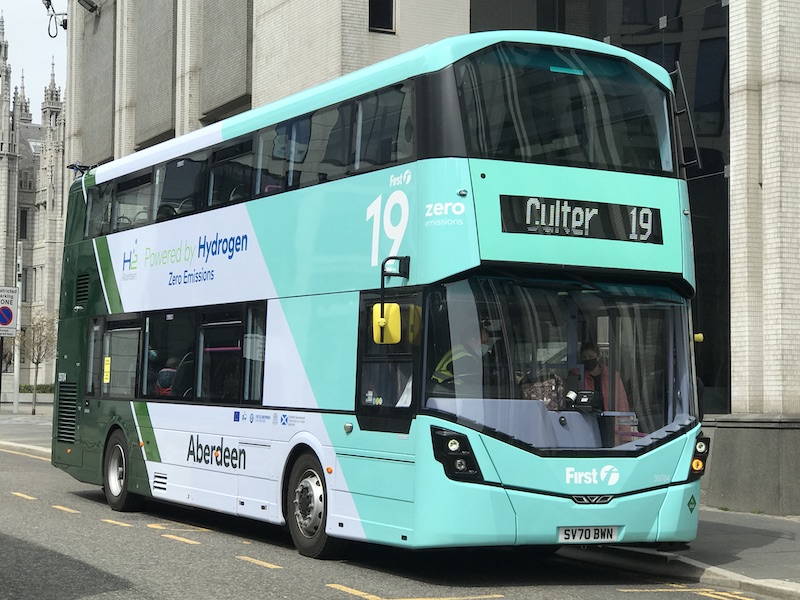
After visiting Kintore Station on Monday I stopped off in Aberdeen to catch up on the latest development in the city’s high profile commitment to hydrogen powered vehicles.
In 2015 First Bus and Stagecoach introduced ten Van Hool A330H hydrogen powered single deck buses between them as phase one of an EU funded trial spearheaded by the city council.
That trial came to an end last year and was regarded by the city council as a resounding success. “The hydrogen bus project is a crucial part of demonstrating energy transition, the net zero journey and bringing our CO2 emissions in the city down” the city council’s hydrogen spokesperson Philip Bell was quoted as saying, adding “the project was phenomenally successful and has given Aberdeen a mature platform seen by the world”. As we’ll see, world recognition is important for Aberdeen.
The buses were scrapped after just five years operation.

The next stage in Aberdeen’s commitment to hydrogen power, known as ‘phase two’, started on 28th January this year when First Bus began operating fifteen hydrogen powered double deck buses manufactured by Wrightbus on its cross city route 19 between Culter and Tillydrone.

Much is being made of the buses being the “world’s first double deck hydrogen buses” with city council politicians and officers ecstatic at achieving such a notable first, not least I suspect because they’ve beaten TfL to the accolade. Similar buses will be introduced in London and Birmingham later this year.

Phase two of the trial is costing £8.3 million with funding coming once again from the EU as well as the city council and Scottish Government. The vehicles cost upwards of £500,000 each.

Naturally much is made of the buses green credentials. There are virtuous messages both externally and internally on the vehicles.

There’s all sorts of statistics you can amaze your friends with if you read all the blurb put out by the city council. “The hydrogen buses save an estimated one kilogram of CO2 per kilometre driven” according to Aberdeen City Council and are therefore “set to transform the air of the city”. Other claims include “the buses are as efficient as electric equivalents, with refuelling taking less than 10 minutes and offering a greater range”.
My eye was also caught by this observation “plans are in place for Aberdeen to make its own hydrogen to power the buses, making it an even greener energy source for the local community”. Why would that be “even greener”, I wondered?
I’m no expert in hydrogen production, but I’m given to understand there are two types: blue hydrogen created from fossil sources, where the carbon emissions are captured and stored and green hydrogen made from non-fossil sources and favoured by environmentalists wary of keeping the fossil economy going. I’m thinking Aberdeen are currently using blue hydrogen but it’s not clear in all the publicity and hype surrounding this trial.
It’s good to know, whether blue or green, the buses are kinder to the environment, however, what I’m really most concerned about is what they’re like to travel in as a passenger. Unless they persuade motorists to make a switch and use their cars less, Aberdeen’s air pollution isn’t going to be radically changed by just 15 buses trundling around on one bus route.
Much is made of the buses quiet operation “the buses will tackle more than just air pollution” the city council extols “as they are virtually silent when they run, helping to create quieter, calmer streets”. There’s no doubt they glide along the road like electric buses without the traditional engine noise associated with a diesel engine but I can’t say I found Aberdeen particularly calm on Monday lunch time.
Indeed, some passengers I encountered during my travels were confused and flustered by the continuing closure of part of the city’s main thoroughfare, Union Street, to supposedly allow for social distancing, and weren’t sure which route buses were taking on diversion, nor where to get off.

And the temporary bus stop build outs on the stretches of Union Street still open seemed to make it harder for passengers with mobility difficulties to board because the raised platforms are too short ….

…. and social distancing was even worse with bus queues spilling across the pavement from the build outs, rather than in a line alongside the kerb where there used to be bus stops and shelters.

On board the half-a-million-pound-a-go buses, it’s clear passenger comfort and convenience hasn’t featured highly in the interior-fit-out spec, if at all.
They have those rather dull tan coloured First Bus faux-leather type seats which always seem a bit dull to me.
For those with accessibility needs, aside from five tip up seats, three on the nearside …

…. and two on the offside ….

…. there are only four ‘proper’ seats providing level access (and then currently restricted to just two due to Covid capacity restrictions).

All the other sixteen seats on the lower deck involve a substantial step up to access them
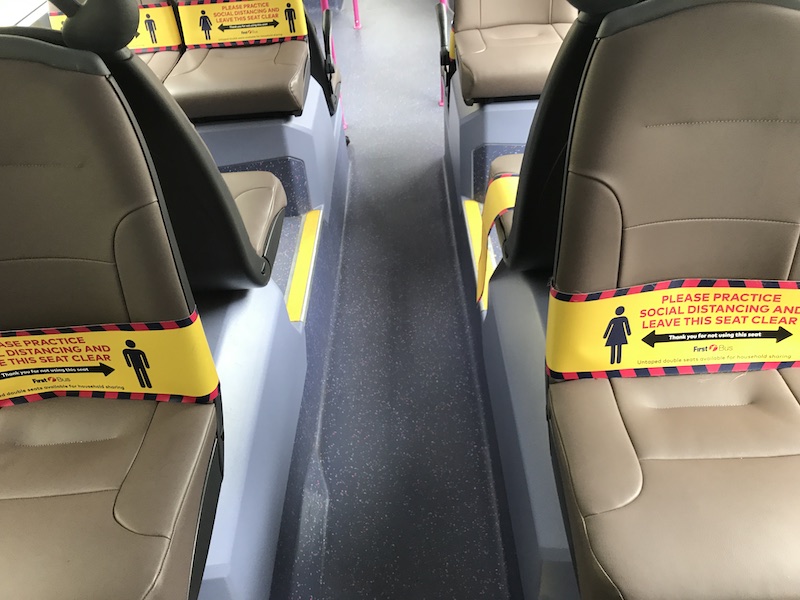
And half of these are facing backwards …

…. involving foot to foot meeting with passengers sitting opposite.


And four are along the extreme rear, which aren’t the most comfortable looking, nor to actually sit in either. I tried it.

The upper deck is similar bog standard First Bus spec.

There’s no visual display showing the next stop, nor even a bus stopping sign.

Just a reminder to mind your head.

There are no USB sockets either.
Having spent half a million on each bus, for the sake of a few thousand more, it would have made a real positive difference to the internal design and ambiance by attending to these issues. Passengers might then feel they’re travelling on something special and take notice of all the virtuous messaging.
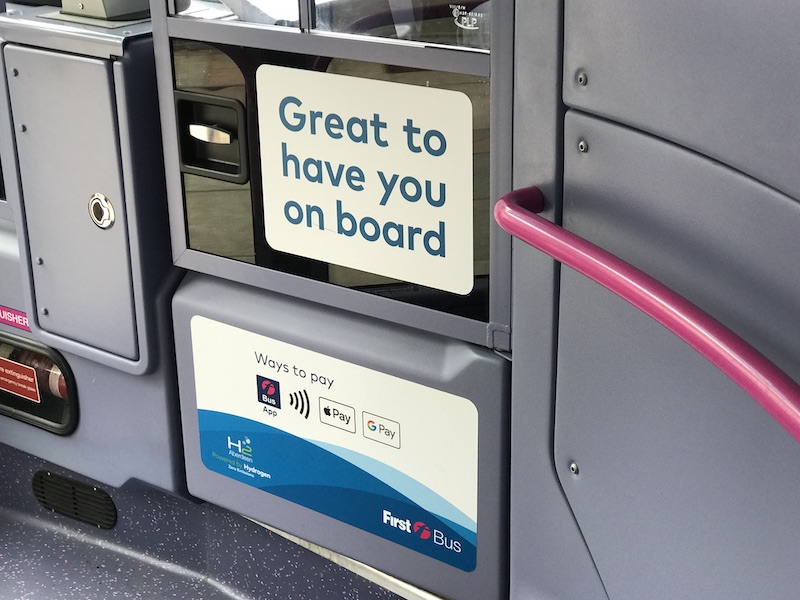
As it is, it comes over these buses are all about the techy stuff. And there’s no doubt that’s important in the context of an expensive trial, but we mustn’t lose sight of the overall objective. To encourage more people to travel by bus. Rather than giving an on board chemistry lesson…

.. it would be better to ensure passenger comfort is not foregone to make room for all the hydrogen gubbins at the rear of the bus. Readers may recall I found the same when trying out the Yutong electric buses First Bus have introduced in Leeds.

Meanwhile at the First Bus depot in KIng Street money has also been spent on adapting the garage infrastructure to accommodate these 15 buses, in particular providing space to ensure the buses can be plugged in at their docking point when parked so their temperature can be monitored. I understand it’s essential the buses are kept above 5°C to ensure pipes don’t freeze and rupture. Sensors have also been installed in the workshop roof to monitor the level of hydrogen when work is carried out on the buses and ensuring there are no leaks. Even the depot lighting has had to be adapted with safety features and grounding points added to ensure there’s no risk of sparking around the hydrogen buses.
When I asked one of the drivers how he found the new buses, he joked he was hoping they won’t follow the Hindenburg airship! Maybe he’d seen all these alterations taking place in the depot.
Route 19 is a busy route and was previously afforded the city’s ‘Platinum’ branding, when that was a thing with First Bus in Aberdeen.

However, being the ‘grumpy old passenger’ (I prefer ‘discerning’ as a descriptor) I am these days, I recall I wasn’t particularly impressed with the interior design and seating in that initiative either.


The front offside seat didn’t even pass the size 9 shoe test.
Some of Aberdeen’s buses are still sporting the Platinum brand but it’s not clear how committed First Bus is to this now the ‘world first’ Hydrogen era has arrived.

It’s also noteworthy the trend followed by Arriva and Stagecoach to close travel shops has spread to First Bus in Aberdeen with their centrally located shop in Union Street now closed.


On my travels on Monday I noticed at least three of the buses out on route 19 were standard single deck buses which might give a clue to the reliability and availability of the hydrogen powered double deck fleet.

I’m not sure how long ‘phase two’ of the trial is. Let’s hope the buses will outlast five years this time.
And the clever people behind the impressive feat of operating a double deck bus on hydrogen spewing out only water – and that really is impressive – now turn their attention to how to accommodate passengers on the lower deck in an accessible and welcoming way.

Roger French


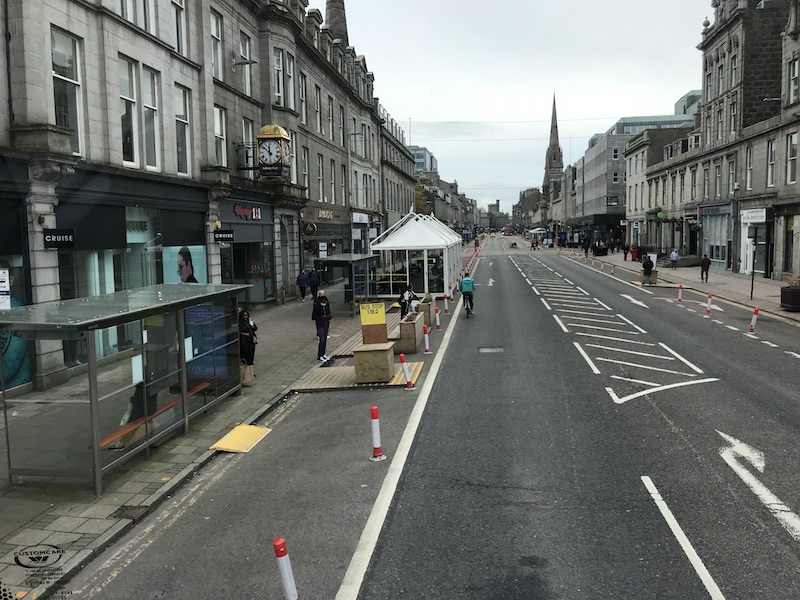
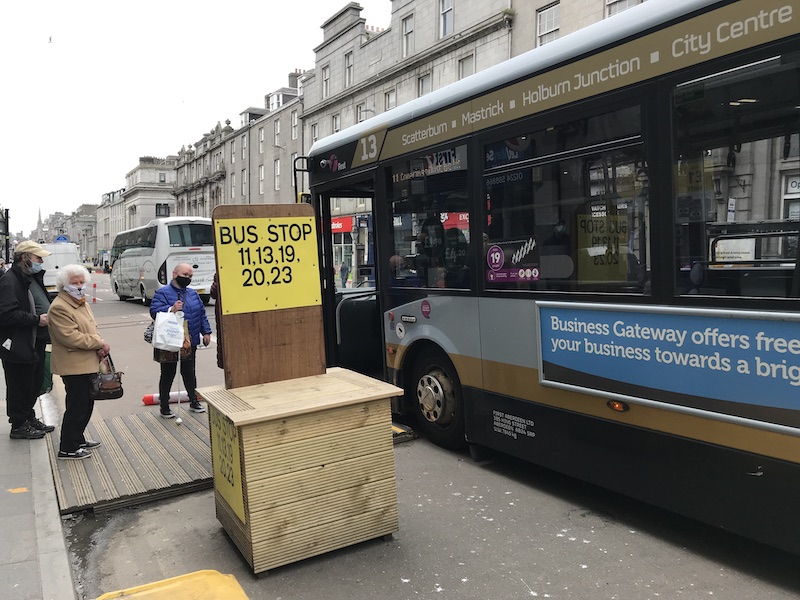
Just changing the color of the interior can made a real difference to ambience, to a bit refreshing. It just looks dull, I would expect USB charging to be a standard spec. in 2021.
LikeLike
The fleet is advertising how brilliant the suppler is (pax don’t care) and failing to attract them with comfort and USB sockets. I know that USB lack is a first world problem but provision really does tempt people out of their cars.
The branding is the same as train operators- who cares if it’s Southern or Thameslink? I just (used to) want to get to London safely quickly and cheaply (those in ascending order).
Just shows that the operator cares more about image than the offer.
LikeLike
The internal specification was set by the council not First. Hence the low back seats and lack of USB chargers.
LikeLike
All the environmental credentials are nullified to me by the fact that the preceeding hydrogen fleet was scrapped after a meagre five years in service. That is abysmal. The internal specification is abysmal and the experience won’t be noticeably different to the average passenger than the 18 year old Volvos that First are still running locally to us. What a waste of an opportunity.
LikeLike
TfL have dabbled with hydrogen on route RV1 without great success
The biggest problem with Hydrogen is costs. The cleanest way to produce hydrogen is to use electricity but you need to put in 3 times as much energy as you get out in the form of hydrogen. The storage of the hydrogen fuel also tends to compromise the bus design and passenger comfort. To date as well the life of these buses has been very short at no more thn 5 years but to date most have been little more than field trial models
The life time and capital costs need to come down for them to be really viable. One advantage over electric they have is Hydrogen can be stored where as electricity cannot be stored in any quantity. The fuel is also expensive. If there is enough surplus wind energy it is possible the energy companies may offer a cheap tariff when there is surplus capacity
LikeLike
According to First Scotland’s managing director Andrew Jarvis the costs of Hydrogen are now comparable/better than diesel. The only cost related issue is that of the vehicles themselves and the infrastructure, but the same argument can be made about any new technology and it should be noted that these Streetdecks cost half what the Vanhools did back in 2013/14.
LikeLike
I am pleased you have pointed out the apalling lower deck layout. As soon as I saw an internal photo of the TfL ones to be operated by Metroline on route 7 (and maybe sometimes on the 245), I could not believe how bad they were for disabled passengers (which currently I have to call myself). Of course being dual door, these are even worse in that respect than the Aberdeen Examples, especially with TfL’s dislike of tip up seats. The rearward facing seats not only mean people’s feet will be touching, but at less busy times, the less polite passengers will want to occupy these seats so that they can put their feet up on the opposite seat. I also felt that the box over the front nearside wheel was much larger than in Aberdeen, thus impeding forward vision, but that could have been because of the angle the photo was taken. Anyway, the installation of the Hydrogen equipment at Metroline’s Perivale depot was delayed by the installation engineers being unable to travel from their country, due to the covid situation (one assumes Aberdeen were able to use the equipment that they already had for the single deckers ?). However, that does seem to now have been completed, as one hydrogen bus appears to have started running on route 7 today. Incidentally, it looks like the two Volvo single deck hydrogen buses formerly on route 444 (originally on route RV1) that had been operated by Tower Transit, will also be heading to Metroline at Perivale, although it is not yet known what use will be found for them, as Perivale currently does not operate any single deck routes.
LikeLiked by 1 person
The vehicles have actually be proving very reliable at around 88% availability, this is comparable and in some cases better than other vehicles in the fleet, for comparison the E300s are around 85%. Although primarily bought for the 19 the 5 unbranded examples see the most use on the 3/3A between Mastrick and Cove, at the moment there isn’t enough of them to cover both routes fully (15 buses to cover 22 duties) so non-Hydrogen buses do appear although usually only on the 3, Aberdeen are receiving a further 10 identical vehicles at the end of the year which will allow full conversion of the 3. On Sundays they also see use on the 1/2.
The interior specification was set by the council, First wanted to go for a higher spec interior but the council wouldn’t allow it. I agree the lower decker layout is poor but hopefully with time it’ll improve, the extra housing forward of the rear axle is mostly for the batteries and the battery cooling system – hence the small vent on the offside..
The Vanhools were not reliable buses and have been disposed of (not scrapped) with one going to a Grampian Transport Museum as an outdoor exhibit and at least two going to Aberdeen University as project vehicles. It should however be noted that the reliability issues with the Vanhools were not related to the Hydrogen side of things which was actually reliable but the vehicles themselves. There was frequent issues with the doors and brakes, the latter in part being because the retarder was on a switch on the dash rather than linked to the brake pedal like on most buses.
Aberdeen already produce their own green Hydrogen through Electrolysis at the refuelling station in Kittybrewster, the electricity used on the site comes directly from the windfarm in Aberdeen bay. There are plans for a larger production site on the outskirts of the city which i suspect is what they’re alluding to.
LikeLike
Many thanks Billie; most informative.
LikeLike
Hydrogen is the most abundant element in the universe and the huge gas giants Jupiter and Saturn are mainly made up of it.it is also very unstable and explosive.remember that other rather more exotic form of public transport the Hindenburg! However I’m sure that First: Transforming Travel have thought about this?they could also try Methane and get it from Moir Lockhead’s Highland Cattle ,which former First oligarch farms somewhere around Aberdeen!
LikeLike
The use of methane as a fuel still produces CO2, whether the source of the methane is the pipeline at St Fergus or the Highland cattle. Others may wish to comment on the relative environmental impact of methane released to atmosphere versus methane burned as fuel and the resultant CO2 released to atmosphere.
Using methane as a fuel for road vehicles eliminates particulate matter from the exhaust. Any road vehicle will still produce particulate matter from wear on its tyres and brakes (other than regenerative electric braking), irrespective of the fuel.
LikeLike